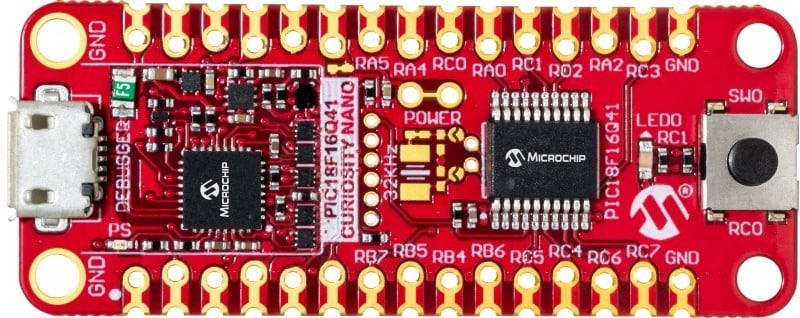Controllers for Improved Sensor Interface Designs
The PIC18-Q41 family of microcontrollers (MCUs) integrates intelligent analog capabilities with powerful Core Independent Peripherals (CIPs) for small, high-performance data acquisition and sensor interfacing applications. These MCUs are uniquely equipped with an Operational Amplifier (OPA), a 12-bit Analog-to-Digital Converter with Computation (ADCC) and two 8-bit Digital-to-Analog Converters (DACs) to provide you with an ideal starting point for any design where signal amplification, filtering and conditioning is needed. Going beyond hardware with our expansive software tool library, you can easily configure peripherals and functions, generate application code and simulate analog circuits prior to hardware prototyping to reduce your development time and speed up your time to market. PIC18-Q41 MCUs are well suited for many applications including medical devices, Internet of Things (IoT) edge nodes, wearables, LED lighting, home automation systems, automotive and motor control applications, and industrial process control. If a cost-effective MCU with comparable performance is needed, PIC18-Q40 MCUs are a good option.
Getting Started
Take your next idea to market with a development board that you can keep in your pocket. With full program and debug capabilities, the PIC18F16Q41 Curiosity Nano Evaluation Kit offers complete support for your next design.
The PIC18-Q41 family is designed to integrate with MPLAB® Code Configurator (MCC), a free software plug-in for our award-winning MPLAB X Integrated Development Environment (IDE), that provides a graphical interface to easily configure peripherals and functions specific to your application. Code examples and analog simulations are also available to help you immediately start your development.

Made for Medical
The PIC18-Q41 family’s unique combination of peripherals makes it an excellent choice for medical devices, especially for applications such as Internet of Medical Things (IoMT) edge nodes, telehealth devices, medical wearables, drug delivery devices and motor control applications. When you combine the capabilities of this family with our experience as an embedded solutions partner to thousands of medical device companies, you can rest assured that your medical product is prepared to go the extra mile.

System Features
Intelligent Sensing Capabilities
On-Chip Op Amp (OPA), 12-bit ADCC, 8-bit DAC, Zero Cross Detect (ZCD)
Integrated analog peripherals for amplification, filtering and signal conditioning are used in sensing and measurement applications. They include an OPA, a ZCD module, comparators, two 8-bit Digital-to-Analog Converter (DACs) and a 12-bit Analog-to-Digital Converter with Computation (ADCC) that automates Capacitive Voltage Divider (CVD) techniques for implementing advanced touch sensing, averaging, filtering, oversampling and automatic threshold comparison.
Improved System Response
Core Independent Peripherals (CIPs)
The configurable CIPs require almost no additional code and no additional components to enable this family of MCUs to handle and accomplish mission-critical and time-sensitive tasks smoothly entirely without CPU intervention. They save Flash memory and allow you to use the CPU’s resources to run complex systems as efficiently as possible. This combination of benefits simplifies your design while reducing power consumption and increasing system responsiveness.
Improved System Performance
Direct Memory Access (DMA)
The PIC18-Q41 family features four Direct Memory Access (DMA) controllers that enable you to quickly transfer data between different memory locations without any CPU interaction. You can use DMA techniques, such as Configuration Context Switching, to reduce power consumption while increasing your system’s performance.
Design Flexibility
16-bit PWM
Delivering advanced capabilities beyond those found on standard PWM modules, the integrated, high-resolution 16-bit PWMs allow you to easily vary phase, duty cycle and offset event count with greater precision. They offer dual independent outputs on the same time base, which helps simplify drive control in a variety of applications. The flexible serial communications interface options include a UART with support for Asynchronous, DMX, DALI and LIN protocols, plus higher-speed, stand-alone I2C and SPI modules.
Hardware Customization
Custom Logic
The four on-board, user-customizable Custom Logic peripherals simplify the implementation of on-board signal and logic control. The Custom Logic peripheral lets you integrate a combination of external and internal signals as inputs and connect on-board peripherals to reduce the number of external components needed for your design, which reduces your PCB footprint and overall system cost.
Power-Conserving Functionality
IDLE, DOZE, Peripheral Module Disable (PMD)
IDLE and DOZE low-power modes allow you to optimize your application for device performance and power consumption. The Peripheral Module Disable (PMD) allows unused peripherals to be turned off individually, further reducing power consumption.
Layout Flexibility
Peripheral Pin Select (PPS)
Peripheral Pin Select (PPS) provides ultimate flexibility when routing digital signals to device pins. With PPS, any digital peripheral can be connected to any I/O pin on the fly for a customized layout. This allows you to maintain layout compatibility with older PIC® MCUs, even as new features are implemented.
Safety First
Functional Safety Ready
The CRC/SCAN module and the Windowed Watchdog Timer (WWDT) work in tandem to provide the necessary tools to incorporate functional safety into your application. By ensuring the integrity of the program Flash contents, the devices support the implementation of safety standards such as Class B and UL 1998.